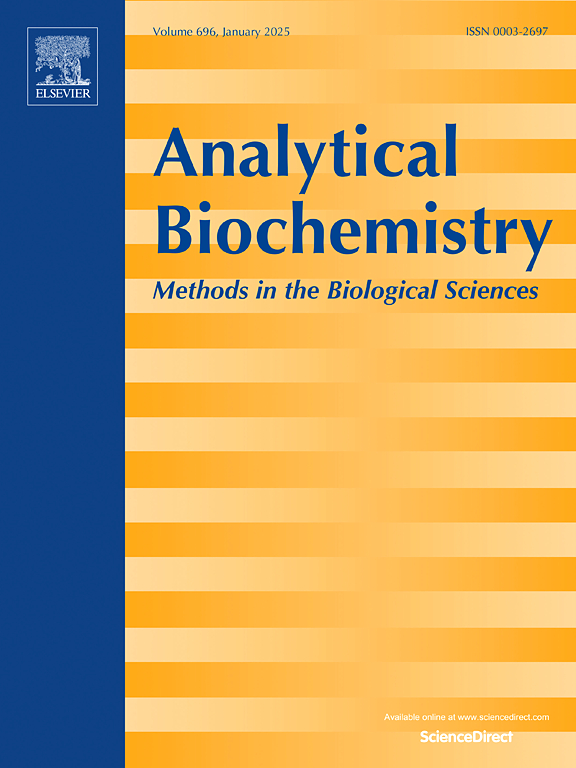Examining cortisol ELISA in dried matrix spots: implications for analyte measurement and stability
IF 2.5
4区 生物学
Q2 BIOCHEMICAL RESEARCH METHODS
引用次数: 0
Abstract
Whole blood, plasma, whole milk and urine samples from domestic goats (Capra hircus) in both liquid and dried form were analysed by quantitative ELISA. Dried matrix samples were prepared using two types of absorbing support: glass fibre strip (strip-dried samples) and cellulose membrane (dried spots). Strip-dried samples have advantages over dried spots due to better cortisol recovery, reproducibility, ease of dried sample aliquoting and no need for recalculations against standard protocol. In the cortisol quantitative ELISA, the best concordance between the results was achieved in the pair “strip-dried whole blood/native plasma” and “strip-dried urine/native urine”. The correlation coefficient of cortisol results in strip-dried blood, plasma and urine vs liquid samples ranged from 0.90 to 0.97 (p < 0.001). The mean recovery of cortisol from blood and plasma samples spotted on cellulose across a wide range of concentrations was much lower that from strip-dried blood and plasma, and varied between 40 and 60 %. Dried plasma samples with high cortisol content (>400 nmol/L) showed a slight decrease in the recovered cortisol concentrations on 20 % average. Cortisol in dried blood, plasma and milk samples was stable over a period of six months at 4 °C, a week at 37 °C or 24 h at 60 °C.

检测皮质醇ELISA在干燥基质斑点:对分析物的测量和稳定性的影响
对家养山羊(Capra hircus)的全血、血浆、全奶和尿液样品进行了液态和干态酶联免疫吸附试验(ELISA)定量分析。干燥基质样品使用两种吸收支撑物制备:玻璃纤维条(条状干燥样品)和纤维素膜(干燥斑点)。条状干燥样品比干燥点状样品的优点是皮质醇回收率更高、重现性更好、干燥样品等分容易,而且无需根据标准方案重新计算。在皮质醇定量酶联免疫吸附试验中,"条干全血/原生血浆 "和 "条干尿液/原生尿液 "的结果一致性最好。条干血液、血浆和尿液与液体样本中皮质醇结果的相关系数在 0.90 至 0.97 之间(p < 0.001)。在不同浓度范围内,纤维素上的血液和血浆样本皮质醇平均回收率远低于带状干燥的血液和血浆样本,在 40% 到 60% 之间。高皮质醇含量(400 nmol/L)的干燥血浆样本的皮质醇回收率略有下降,平均为 20%。干血、血浆和牛奶样本中的皮质醇在 4 °C 下 6 个月、37 °C 下一周或 60 °C 下 24 小时内均保持稳定。
本文章由计算机程序翻译,如有差异,请以英文原文为准。
求助全文
约1分钟内获得全文
求助全文
来源期刊

Analytical biochemistry
生物-分析化学
CiteScore
5.70
自引率
0.00%
发文量
283
审稿时长
44 days
期刊介绍:
The journal''s title Analytical Biochemistry: Methods in the Biological Sciences declares its broad scope: methods for the basic biological sciences that include biochemistry, molecular genetics, cell biology, proteomics, immunology, bioinformatics and wherever the frontiers of research take the field.
The emphasis is on methods from the strictly analytical to the more preparative that would include novel approaches to protein purification as well as improvements in cell and organ culture. The actual techniques are equally inclusive ranging from aptamers to zymology.
The journal has been particularly active in:
-Analytical techniques for biological molecules-
Aptamer selection and utilization-
Biosensors-
Chromatography-
Cloning, sequencing and mutagenesis-
Electrochemical methods-
Electrophoresis-
Enzyme characterization methods-
Immunological approaches-
Mass spectrometry of proteins and nucleic acids-
Metabolomics-
Nano level techniques-
Optical spectroscopy in all its forms.
The journal is reluctant to include most drug and strictly clinical studies as there are more suitable publication platforms for these types of papers.
 求助内容:
求助内容: 应助结果提醒方式:
应助结果提醒方式:


